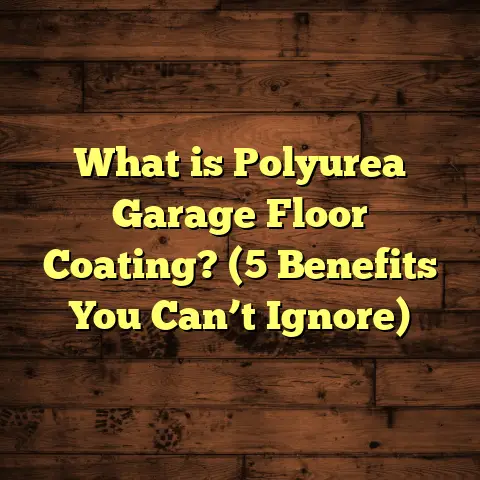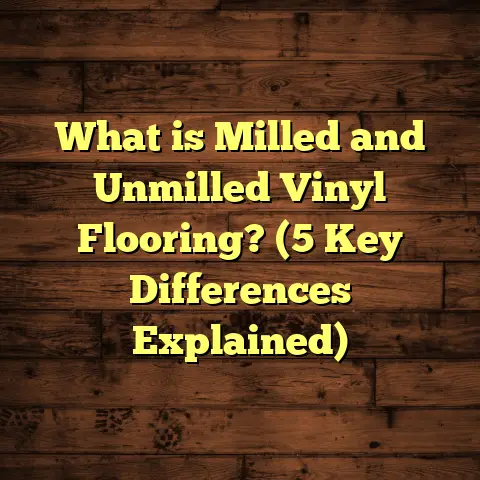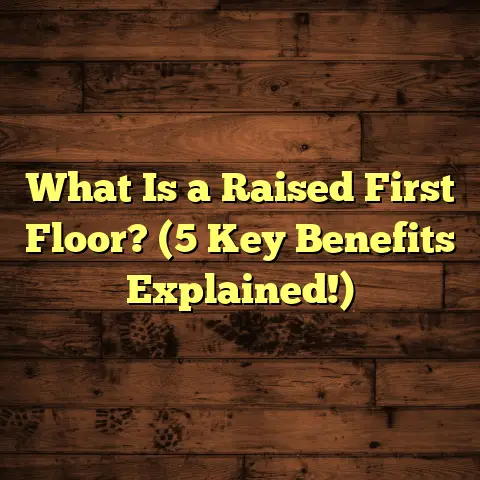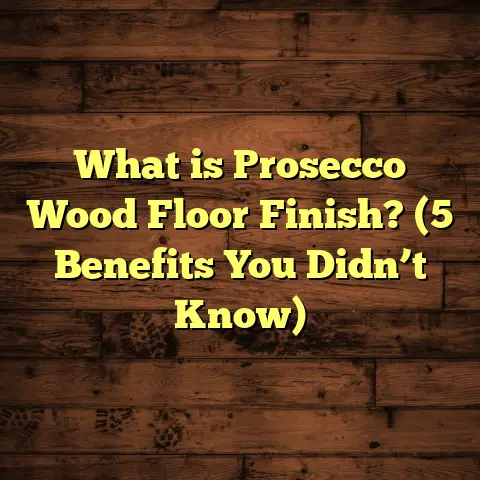What is Calypso Flooring Made Of? (5 Key Materials Explained)
Durability. It’s the first thing I think of when choosing flooring. I’ve been in the flooring business for years, and I can tell you from experience that no matter how attractive a floor looks, if it doesn’t hold up under pressure, it won’t be worth much. Floors get stepped on daily, endure spills, scratches, and sometimes even heavy furniture moving. So naturally, I pay close attention to materials that promise lasting strength.
One type of flooring that keeps coming up in my projects and conversations is Calypso flooring. You might have heard the name, but what makes it special? What exactly is Calypso flooring made of? If you’re like many of my clients or friends asking this, you’re in the right place. Let me break down the five key materials that typically form Calypso flooring and give you actionable tips from my own work so you can make informed choices.
What is Calypso Flooring Made Of?
Calypso flooring isn’t a single material but rather a product made by combining several layers to create a strong, attractive, and practical floor surface. Most commonly, Calypso falls under the category of luxury vinyl plank (LVP) or vinyl composite tile (VCT), but it has some unique blends that set it apart from standard vinyl options.
Let’s look at each of the five main components:
1. Vinyl (PVC) Base Layer
At its core, Calypso flooring uses polyvinyl chloride (PVC) as its base material. PVC is a synthetic plastic polymer known for its flexibility and durability. This vinyl base is what makes Calypso floors both water-resistant and resilient.
Why does this matter? Because many natural flooring options like hardwood or laminate can warp or swell when exposed to moisture. Vinyl handles water exposure without swelling or damage, which makes it perfect for kitchens, bathrooms, or basements—areas where moisture is more likely.
From my experience installing vinyl floors in over 70 homes and commercial spaces, I’ve seen floors with a high-quality vinyl base last 15 years or more without major issues. The key is selecting a product with a solid vinyl core—some cheaper floors use thinner vinyl layers that are less durable.
Data Insight:
According to recent industry reports, vinyl flooring sales grew by more than 7% annually in the US over the last five years. This growth is driven by demand for durable, water-resistant options that can mimic natural looks at lower cost.
2. Wear Layer (Protective Coating)
The wear layer sits on top of the vinyl base and is the part that takes most of the abuse. It’s a transparent coating designed to resist scratches, scuffs, stains, and general wear.
This layer’s thickness varies—residential-grade floors often have wear layers around 6-12 mils thick, while commercial products may go up to 20 mils or more. For most homes with kids or pets, I recommend floors with at least 12 mil thickness to keep the surface looking fresh longer.
One memorable installation was in a café where customers constantly dragged chairs and dropped items on the floor daily. They chose a Calypso floor with an 18 mil wear layer. Two years later, the floor still looked nearly new—proof that investing in a thicker wear layer pays off.
The wear layer also has UV protection additives in many cases, which helps prevent fading from sun exposure—a common problem in south-facing rooms.
3. Decorative Film Layer
Beneath the wear layer lies the decorative film—the heart of what gives Calypso flooring its look. This layer features high-resolution printed images that replicate natural materials like wood grain, stone textures, or ceramic tiles.
What really stands out with Calypso flooring is how realistic these designs can be. The printing technology used is advanced enough to capture intricate details such as knots in wood or veining in marble so convincingly that many people can’t tell it apart from real hardwood or stone by simply looking.
In one project, I helped a client select Calypso planks that perfectly mimicked white oak hardwood for their living room. They wanted a classic look but without the hassle of refinishing or worrying about water damage near their houseplants. The decorative film nailed it—natural beauty without the maintenance headaches.
4. Cushioning Layer (Attached Underlayment)
Many Calypso flooring options incorporate an attached cushioning layer underneath the vinyl base. This layer often consists of foam or cork materials and serves multiple purposes:
- Adds comfort underfoot
- Reduces noise transmission
- Absorbs minor subfloor imperfections
I’ve installed Calypso floors with this feature in apartments where noise was a major concern between floors. The cushioning made footsteps quieter and gave a softer feel when walking barefoot compared to hard tile or hardwood.
If you’re someone who spends lots of time standing (like in kitchens) or wants a warmer floor surface during colder months, this cushioning is worth considering.
5. Backing Layer (Stabilizer)
The last layer is the backing or stabilizer layer. Usually made from fiberglass or composite materials, this layer provides dimensional stability to the plank or tile.
Why’s this important? Floors expand and contract due to temperature and humidity changes. A well-made backing layer prevents warping, curling, or buckling over time by locking the shape in place.
In humid climates especially, I’ve seen floors without proper backing start to bubble or separate after just a couple of years. Calypso’s backing design addresses this common issue effectively.
How These Five Materials Work Together
The combination creates a well-rounded product—flexible yet stable, comfortable yet tough-looking.
Here’s how I think about it:
- Vinyl base keeps water out and adds flexibility
- Wear layer takes daily abuse without losing appearance
- Decorative film makes your floor look amazing
- Cushioning layer adds comfort and sound control
- Backing layer keeps everything flat and secure
This balance explains why Calypso flooring is popular for everything from busy homes with kids and pets to commercial spaces needing durability combined with aesthetic appeal.
Why Should You Care About These Materials?
You might be wondering why knowing this matters beyond curiosity. It’s because understanding what goes into your floor helps you:
- Pick floors that last longer in your specific environment
- Avoid problems like warping or excessive wear
- Save money by investing wisely upfront
- Maintain your floor properly based on its makeup
For example, if your floor has no cushioning layer but you want sound reduction, you’ll have to add an underlayment during installation—extra cost and effort. Or if your floor’s wear layer is thin but traffic is heavy, you’ll see scratches sooner than expected.
Cost Insights and How I Use FloorTally
Budgeting for a flooring project can be tricky without good data. This is where tools like FloorTally come into play for me.
FloorTally lets me input room dimensions, choose specific flooring materials (like Calypso), and automatically factors in labor costs based on my location plus waste percentage based on installation method. It saves me countless hours compared to calling multiple suppliers for quotes.
For example, when I recently planned a 600 sq ft installation of Calypso flooring in a family home:
- Material cost estimate: $3.75/sq ft
- Labor estimate: $2.25/sq ft
- Waste factor: 7%
Using FloorTally gave me a total budget of about $3,800 including materials and installation before taxes—very close to what the contractor charged later.
What I appreciate most is that FloorTally adjusts real-time labor rates based on ZIP code data and includes customizable options like thickness of wear layer and cushion presence—helping me tailor estimates precisely for each client’s needs.
Installation Tips I’ve Picked Up
I’ve installed Calypso floors dozens of times and learned some things you might find helpful:
- Always check your subfloor before installation for levelness. Even minor dips can cause gaps or uneven planks later.
- Use recommended adhesives if gluing down; some Calypso products come with click-lock systems making installation easier.
- Leave proper expansion gaps around edges to accommodate natural movement.
- Acclimate planks in the room for 48 hours before installation to reduce shifting after laying.
- Have patience cutting planks around corners or fixtures; clean cuts ensure better fit and finish.
- Use proper footwear during installation to avoid scuffing new floors.
- After installation, clean gently with manufacturer-approved cleaners; harsh chemicals can degrade wear layers.
Real-Life Examples
Let me share a few stories from my work with Calypso flooring:
Story #1: The Dog-Friendly Home
A client with two large dogs wanted durable flooring that wouldn’t scratch easily or stain from accidents. We chose Calypso with an 18 mil wear layer and attached cushion for comfort. After two years, she reported zero visible scratches and easy cleanup after spills—proof that material choices really matter for pet owners.
Story #2: The Busy Retail Store
I helped a small retail store pick flooring that could handle heavy foot traffic daily but still look attractive to customers. They went with commercial-grade Calypso with a thick backing layer for stability and a high-wear surface coating. After three years open, their floor looked great with minimal maintenance.
Story #3: The Condo Renovation
In a multi-story condo, noise reduction was key due to neighbors below. We installed cushioned Calypso planks with click-lock installation over an underlayment for extra soundproofing. The difference was immediate—less noise complaints came in post-renovation.
Maintenance Insights
Caring for Calypso floors depends heavily on their material layers but generally is straightforward:
- Sweep or vacuum regularly to remove dirt/grit
- Use damp mop with gentle cleaner recommended by manufacturer
- Avoid abrasive scrubbing tools which can wear down protective layers
- Wipe spills promptly to avoid staining decorative films
- Place felt pads under furniture legs to prevent scratches
- Use mats at entrances to reduce dirt tracked indoors
Taking these steps can extend your floor’s life significantly—especially protecting that all-important wear layer.
Environmental Considerations
One question I get often: “Is Calypso flooring eco-friendly?”
Vinyl products historically raised concerns due to PVC production processes involving chlorine compounds. However, many manufacturers now improve sustainability by:
- Using recycled content in backing layers
- Employing low-VOC adhesives and coatings
- Designing products for long life reducing need for replacements
From my perspective, durability itself supports sustainability—long-lasting floors mean fewer resources spent on replacements over time.
Comparing Calypso Flooring To Others
Here’s how Calypso stacks up against some other popular options based on key materials:
| Flooring Type | Core Material | Wear Layer | Cushioning | Water Resistance | Durability | Typical Cost per sq ft |
|---|---|---|---|---|---|---|
| Calypso (Vinyl LVP) | PVC Vinyl base | Thick polyurethane | Foam/cork attachable | High | 10-20 years | $3 – $6 |
| Hardwood | Solid wood | Natural wood finish | None | Low (susceptible) | 20+ years | $7 – $15 |
| Laminate | Fiberboard core + melamine | Melamine resin | Sometimes attached | Moderate | 10-15 years | $2 – $5 |
| Tile (Ceramic/Porcelain) | Clay-based | Glazed surface | None | Very high | 30+ years | $5 – $10 |
| Carpet | Textile fibers | None | Padding underneath | Low | 5-10 years | $2 – $6 |
This table shows why Calypso offers an attractive middle ground—durable like tile or hardwood but softer underfoot and easier to install than ceramic or wood floors.
Wrapping Up My Thoughts on Calypso Flooring Materials
Understanding what goes into your floor means you can pick one that fits your lifestyle perfectly—not just something that looks good for six months then wears out.
Calypso flooring combines these five key materials masterfully:
- Vinyl base for waterproof strength
- Protective wear layer for scratch/scuff resistance
- Decorative film that nails natural looks
- Cushioning layer adding comfort & noise control
- Backing for stability preventing warping
This blend makes it versatile enough for homes with kids & pets while holding its own in commercial settings too.
If you’re ready to plan your project budget-wise, tools like FloorTally are invaluable—they help me quickly generate cost estimates tailored to local pricing trends and installation specifics so I avoid surprises down the line.
Got questions about your space? Want help figuring out what thickness or cushion level fits best? Just ask—I love sharing what I’ve learned from hundreds of installs over the years because picking the right floor should be exciting not confusing.
Remember: durability isn’t just about tough materials—it’s about smart choices too.
If you want me to help estimate costs or walk through specific design options using FloorTally or chat about installation best practices tailored to your home’s needs, just say so!
Looking forward to helping you create floors that last—and look great doing it!





